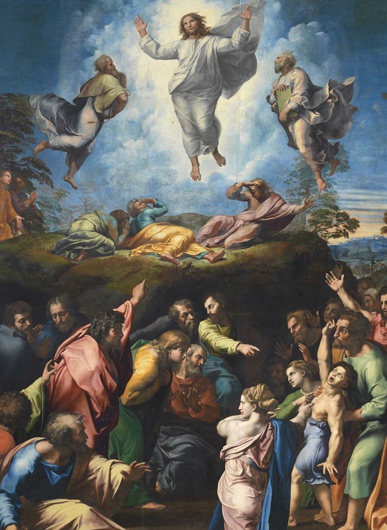
Raffaello Sanzio da Urbino, better known as Raphael, stands as a towering figure in the realm of High Renaissance art.
Born in 1483, his mastery of form, color, and emotion transformed the art world, leaving an indelible mark that continues to inspire.
His ability to depict complex human emotions with remarkable realism is a hallmark of his work, making him one of the most celebrated artists alongside Michelangelo and Leonardo da Vinci.
This article explores ten of Raphael’s most famous paintings, from the iconic School of Athens to the serene Madonna della seggiola.
Each piece not only showcases his artistic genius but also reflects the cultural and philosophical currents of the Renaissance. Join us as we delve into these masterpieces that continue to captivate audiences centuries later.
1. The School of Athens

The School of Athens, created between 1509 and 1511, stands as Raphael’s most celebrated work. It showcases an assembly of great philosophers, with Plato and Aristotle at the center.
The painting mirrors the ideals of the Renaissance, harmonizing art, philosophy, and science. Raphael ingeniously included prominent figures of his time in the characters.
Notable inclusions are the faces of Michelangelo as Heraclitus and Leonardo da Vinci as Plato. This masterpiece resides in the Apostolic Palace, Vatican City, serving as a pivotal symbol of intellectual thought.
2. Sistine Madonna

Sistine Madonna, painted around 1512, showcases Raphael’s mastery of religious themes and composition. This iconic artwork features the Virgin Mary holding the Christ Child, flanked by Saint Sixtus and Saint Barbara.
The serene expressions and flowing drapery highlight Raphael’s ability to convey emotion and divinity. Notably, the cherubs at the bottom exude innocence and purity, becoming enduring symbols of art.
Currently housed in the Dresden Gallery, this painting remains a profound example of High Renaissance artistry, reflecting both faith and artistic genius.
3. Disputation of the Holy Sacrament

Disputation of the Holy Sacrament, painted in the early 16th century, exemplifies Raphael’s theological sophistication.
The fresco, located in the Stanza della Segnatura at the Vatican, depicts Christ, the Virgin Mary, and saints above theologians engaged in a profound discussion about the Eucharist.
Raphael masterfully balances the celestial and earthly realms, illustrating the connection between heaven and the Church.
This painting not only embodies Christian doctrine but also highlights Raphael’s ability to intertwine faith with intellectual discourse, showcasing his pivotal role in Renaissance art.
4. Transfiguration

Transfiguration, completed in 1520, is Raphael’s final painting, housed in the Vatican Pinacoteca. This monumental work brilliantly depicts two biblical tales: Christ’s transfiguration with Moses and Elijah above and the miracle of healing a possessed boy below.
The painting exemplifies chiaroscuro, masterfully contrasting light and shadow. Critics have praised it as a pinnacle of Raphael’s artistry.
It serves as a bridge between the High Renaissance and the Baroque, profoundly influencing future artists while showcasing Raphael’s incredible talent and emotional depth.
5. The Triumph of Galatea

The Triumph of Galatea, painted by Raphael around 1512, resides in the Villa Farnesina, Rome. This fresco illustrates Galatea, a sea nymph, joyfully pursued by Acis, a mortal shepherd. Cyclops Polyphemus, envious of their love, tragically eliminates Acis.
Raphael’s colors and dynamic figures exemplify his mastery in depicting movement and emotion.
The artwork blends mythological themes with exquisite detail, representing ideals of love and beauty central to the Renaissance, showcasing Raphael’s exceptional skill and artistic vision.
6. La Fornarina
La Fornarina, painted around 1518, is one of Raphael’s most intimate portraits. This artwork features a young woman, widely believed to be his muse and lover, expressing serene beauty and emotional depth.
The woman’s flowing hair and intricate garments highlight Raphael’s attention to detail. Subtle elements like the rose in her hand symbolize both love and secrecy.
Currently housed in the Palazzo Barberini, this painting captures the essence of Renaissance ideals through its vivid colors and naturalism, showcasing Raphael’s unparalleled ability to convey human emotion.
7. Expulsion Of Heliodorus

Expulsion of Heliodorus, painted between 1511 and 1512, resides in the Vatican’s Stanza di Heliodoro. This dramatic fresco captures the moment Heliodorus, a Greek envoy, is expelled from the Temple of Jerusalem.
The colors and dynamic composition showcase Raphael’s mastery of space and emotion. He depicts heavenly figures, including angels, intervening to protect the sanctity of the Temple.
This work exemplifies Raphael’s ability to intertwine narrative and spirituality, emphasizing the triumph of divine justice over earthly power.
8. Stanza della Segnatura

Stanza della Segnatura, located in the Apostolic Palace, serves as a crucial site for Raphael’s artistic legacy. It boasts four monumental frescoes, each representing one of the four branches of knowledge: Philosophy, Theology, Poetry, and Law.
Among these, The School of Athens stands as the hallmark of Renaissance artistry. The Disputation of the Holy Sacrament embodies theological depth.
These frescoes not only illustrate Raphael’s mastery of composition and color but also promote the ideals of the Renaissance, merging art with intellectual ambition.
9. The Marriage of the Virgin

Raphael’s The Marriage of the Virgin, completed in 1504, showcases his early mastery in balancing emotion and form.
This oil on panel painting depicts the wedding ceremony of Mary and Joseph, framed by a beautifully detailed temple that highlights Raphael’s skill in perspective.
Dimensions of 174 cm by 121 cm make it a striking piece, originally commissioned for a Benedictine monastery. Today, it’s housed in the Pinacoteca di Brera in Milan, captivating viewers with its elegance and innovative composition.
10. The Three Graces

The Three Graces, painted between 1503 and 1508, showcases Raphael’s early exploration of the female nude.
The artwork features three elegantly posed women, possibly representing Greek nymphs, gracefully caressing each other.
Each lady holds a gilded orb, symbolizing abundance and connection to femininity. The delicate rendering illustrates Raphael’s skill in portraying realism and emotion, marking a significant departure from the use of male models.
Housed in the Château de Chantilly, this painting is a testament to Raphael’s evolving artistic vision and mastery.






